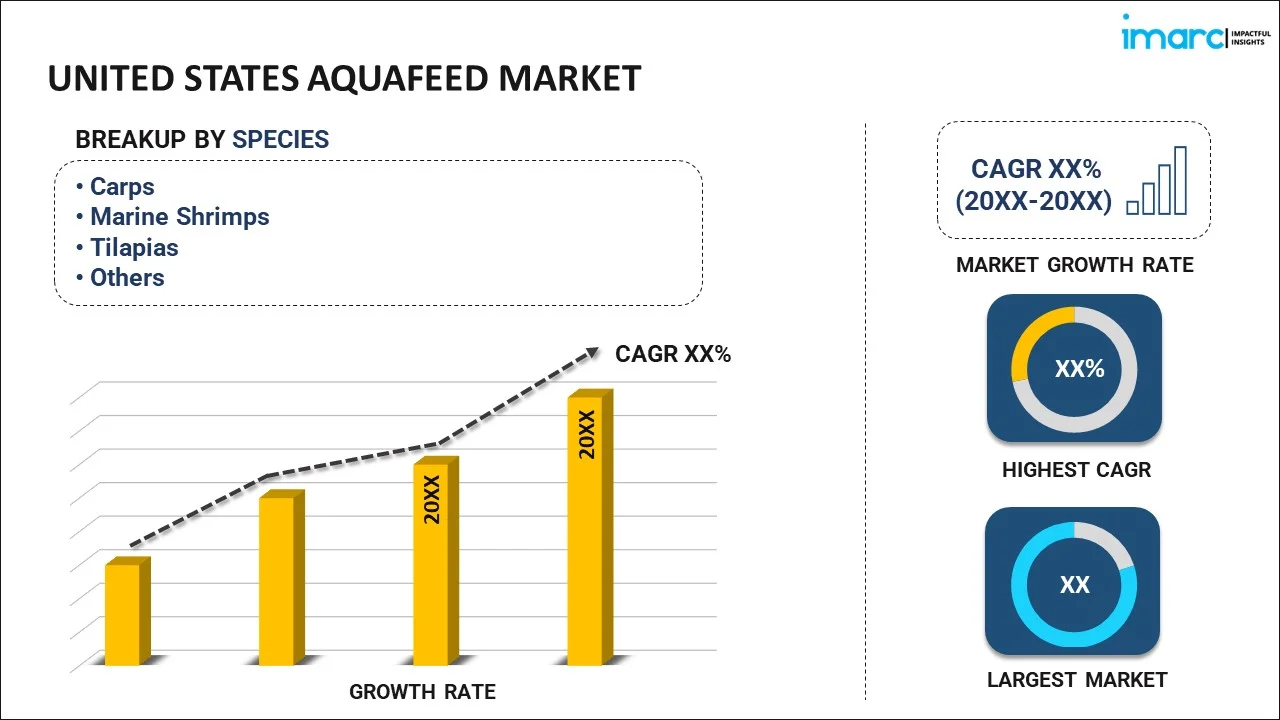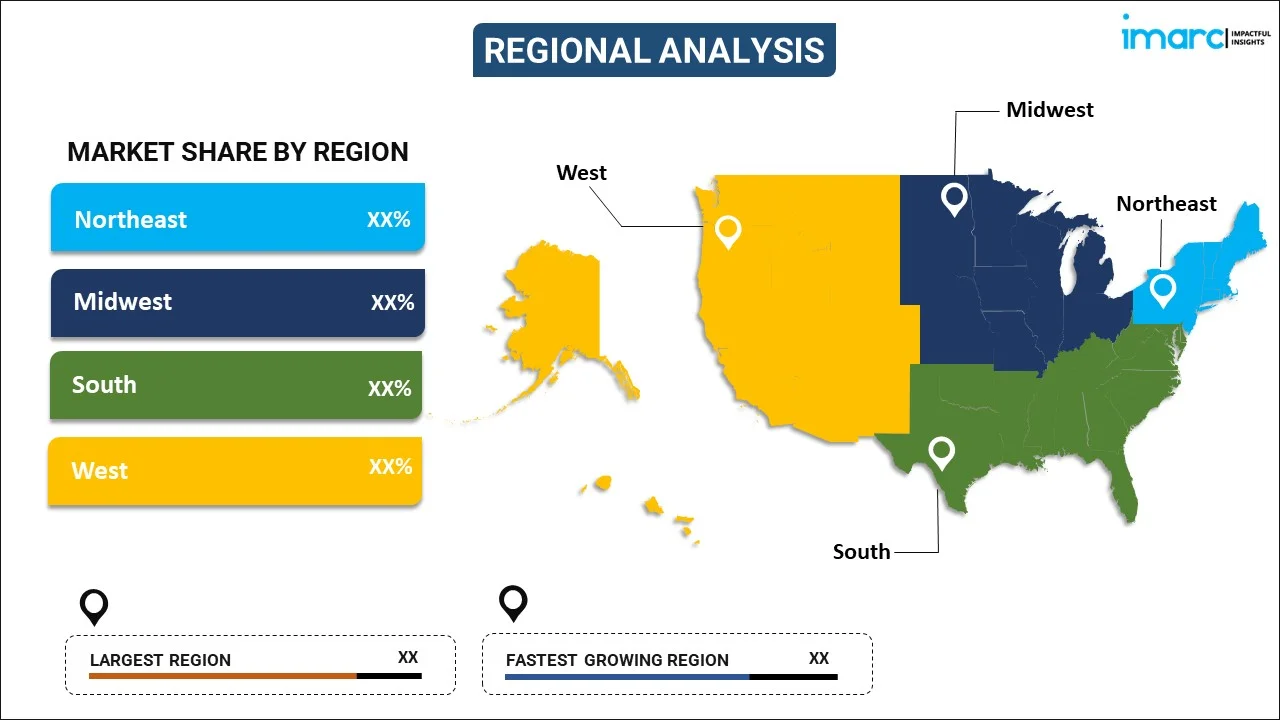
United States Aquafeed Market Report by Specie (Carps, Marine Shrimps, Tilapias, Catfishes, Marine Fishes, Salmons, Freshwater Crustaceans, Trout, and Others), Ingredients (Soybean, Corn, Fish Meal, Fish Oil, Additives, and Others), Additive (Vitamins and Minerals, Antioxidants, Feed Enzymes, and Others), Product Form (Pellets, Extruded, Powdered, Liquid), and Region 2025-2033
United States Aquafeed Market Size, Share & Analysis:
The United States aquafeed market size reached USD 45,166.5 Million in 2024. Looking forward, IMARC Group expects the market to reach USD 67,191.1 Million by 2033, exhibiting a growth rate (CAGR) of 4.51% during 2025-2033. The increasing demand for seafood products in the United States, continuous research and innovation in aquafeed formulations, and the introduction of supportive policies and incentives for sustainable aquaculture represent some of the key factors driving the market.
|
Report Attribute
|
Key Statistics
|
|---|---|
|
Base Year
|
2024 |
|
Forecast Years
|
2025-2033
|
|
Historical Years
|
2019-2024
|
| Market Size in 2024 | USD 45,166.5 Million |
| Market Forecast in 2033 | USD 67,191.1 Million |
| Market Growth Rate (2025-2033) | 4.51% |
United States Aquafeed Market Insights:
- Major Market Trends: Increased aquaculture production, mounting consumer demand for protein-rich seafood, and advancements in the science of feed nutrition are driving heightened use of specialty aquafeed products among different species of fish and shellfish propelling, United States aquafeed market share.
- Key Market Trends: The trend towards sustainable ingredients, functional additives for fish health, and precision feeding systems is defining aquafeed development, mirroring the industry's emphasis on environmental sustainability, animal welfare, and production efficiency in current aquaculture systems.
- Competitive Landscape: Players are boosting product differentiation with innovation in feed formula, widening distribution networks, and integrating digital technologies to enable aquaculture operations. Research investments and localized solutions are enabling players to consolidate market presence.
- Challenges and Opportunities: Dwindling cost of conventional feed ingredients and volatile supply chains are challenging, whereas opportunities exist through innovation of new protein sources, enhancing feed conversion efficiency, and aligning with changing rules and sustainability objectives in aquaculture.
United States Aquafeed Market Trends:
Increased Adoption of Functional and Nutritionally Enhanced Aquafeed
The US aquafeed industry is experiencing a robust trend towards functional and nutritionally superior formulations with the aim of enhancing the health, growth rate, and disease resistance of aquaculture animals. Feed profiles are being formulated to suit the individual dietary requirements of various fish and shellfish through the use of essential amino acids, vitamins, and probiotics. The trend represents an overall focus on precision aquaculture with emphasis on feed conversion efficiency and sustainability. With aquaculture becoming more complex, manufacturers are counting on sophisticated feed technologies to provide maximum yields and biosecurity compliance. Moreover, natural additives and immune stimulants enhance long-term stock well-being and minimize the need for pharmaceuticals. High-performance feed is a major impetus for the anticipated United States aquafeed market growth in line with changing production practices and consumer demand for sustainably produced seafood.
Growing of Plant-Based and Alternative Protein Ingredients
Driven by sustainability goals and the fluctuating prices of raw materials, the American aquafeed market is steadily shifting toward plant-based and alternative protein ingredients. Soy protein concentrates, algae meal, insect-based proteins, and single-cell organisms are being incorporated more into commercial feed on a regular basis to minimize reliance on fishmeal and fish oil. This transition not only helps in environmental sustainability but also facilitates scalable aquaculture production by maintaining feed supplies and economy. Nutritional efficacy of the substitutes has substantially enhanced with the support of research and formulation improvements. Suppliers are maximizing digestibility and nutrient uptake in species-level feeds utilizing these new inputs. The innovation is being facilitated through regulatory mechanisms and academic cooperation, embedding it further into mainstream aquafeed practices. The increasing dependence on alternative proteins is a benchmark characteristic of United States aquafeed market trends, with the demonstration of a basic shift in ingredient procurement strategies throughout the value chain.
Embracing Digital Technologies in Feed Management
Digitalization of aquafeed management is increasingly gaining acceptance throughout U.S. aquaculture facilities, allowing enhanced precision, efficiency, and traceability in feeding operations. For instance, in March 2025, Aquaculture America highlighted cutting-edge technologies in aquafeed processing, intelligent monitoring, and precision farming, affirming the industry's passion for innovation, sustainability, and operational efficiency across aquaculture systems. Moreover, technologies like automated, underwater feeders, real-time biomass, and AI-based analytics are being implemented to refine feed delivery and reduce waste. These technologies enable producers to constantly track fish behavior, environmental conditions, and feed intake from which improved resource efficiency and lower operational expenses are realized. Integrated systems such as these boost growth performance and minimize environmental burden, which is achieved through more effective feeding patterns and optimized rations. Smart feeding system adoption is becoming a competitive aquaculture strategic resource, encouraging data-driven decision-making across the entire production process. With digital infrastructure in wider reach and lower cost, its contribution to optimizing feed is likely to increase, underpinning insights from United States aquafeed market analysis and driving quantifiable improvements in productivity and profitability.
United States Aquafeed Market Segmentation:
IMARC Group provides an analysis of the key trends in each segment of the market, along with forecasts at the country level for 2025-2033. Our report has categorized the market based on species, ingredients, additives, and product form.
Species Insights:

To get more information on this market, Request Sample
- Carps
- Marine Shrimps
- Tilapias
- Catfishes
- Marine Fishes
- Salmons
- Freshwater Crustaceans
- Trout
- Others
The report has provided a detailed breakup and analysis of the market based on the species. This includes carps and marine shrimps, tilapias, catfishes, marine fishes, salmons, freshwater crustaceans, trout, and others.
Ingredients Insights:
- Soybean
- Corn
- Fish Meal
- Fish Oil
- Additives
- Others
A detailed breakup and analysis of the market based on ingredients have also been provided in the report. This includes soybean, corn, fish meal, fish oil, additives, and others.
Additives Insights:
- Vitamins and Minerals
- Antioxidants
- Feed Enzymes
- Others
The report has provided a detailed breakup and analysis of the market based on the additives. This includes vitamins and minerals, antioxidants, feed enzymes, and others.
Product Form Insights:
- Pellets
- Extruded
- Powdered
- Liquid
A detailed breakup and analysis of the market based on product forms have also been provided in the report. This includes pellets, extruded, powdered, and liquid.
Regional Insights:

- Northeast
- Midwest
- South
- West
The report has also provided a comprehensive analysis of all the major regional markets, which include the Northeast, Midwest, South, and West.
Competitive Landscape:
The market research report has also provided a comprehensive analysis of the competitive landscape in the market. Competitive analysis such as market structure, key player positioning, top winning strategies, competitive dashboard, and company evaluation quadrant has been covered in the report. Also, detailed profiles of all major companies have been provided.
Latest News and Developments:
- In April 2025, AlgiSys BioSciences plans to introduce a non-GMO, EPA-enriched microalgae aquafeed ingredient for the replacement of fishmeal and fish oil in salmon and shrimp aquaculture. The environmentally friendly, protein-dense powder seeks to ease marine resource strain, with commercial-scale production anticipated within one year subject to successful trials and investment.
United States Aquafeed Market Report Coverage:
| Report Features | Details |
|---|---|
| Base Year of the Analysis | 2024 |
| Historical Period | 2019-2024 |
| Forecast Period | 2025-2033 |
| Units | Million USD |
| Scope of the Report | Exploration of Historical and Forecast Trends, Industry Catalysts and Challenges, Segment-Wise Historical and Predictive Market Assessment:
|
| Species Covered | Carps, Marine Shrimps, Tilapias, Catfishes, Marine Fishes, Salmons, Freshwater Crustaceans, Trout, Others |
| Ingredients Covered | Soybean, Corn, Fish Meal, Fish Oil, Additives, Others |
| Additives Covered | Vitamins and Minerals, Antioxidants, Feed Enzymes, Others |
| Product Forms Covered | Pellets, Extruded, Powdered, Liquid |
| Regions Covered | Northeast, Midwest, South, West |
| Customization Scope | 10% Free Customization |
|
Post-Sale Analyst Support |
10-12 Weeks |
| Delivery Format | PDF and Excel through Email (We can also provide the editable version of the report in PPT/Word format on special request) |
Key Benefits for Stakeholders:
- IMARC’s industry report offers a comprehensive quantitative analysis of various market segments, historical and current market trends, market forecasts, and dynamics of the United States aquafeed market from 2019-2033.
- The research report provides the latest information on the market drivers, challenges, and opportunities in the United States aquafeed market.
- Porter's five forces analysis assist stakeholders in assessing the impact of new entrants, competitive rivalry, supplier power, buyer power, and the threat of substitution. It helps stakeholders to analyze the level of competition within the United States aquafeed industry and its attractiveness.
- A competitive landscape allows stakeholders to understand their competitive environment and provides an insight into the current positions of key players in the market.
Key Questions Answered in This Report
The aquafeed market in the United States was valued at USD 45,166.5 Million in 2024.
The United States aquafeed market is projected to exhibit a CAGR of 4.51% during 2025-2033, reaching a value of USD 67,191.1 Million by 2033.
Key drivers of the United States aquafeed market are growing demand for aquaculture products, growing emphasis on producing seafood sustainably, and technological advancements in feed formulation. In addition, expanded use of inland aquaculture farms, rising awareness of fish nutrition and health, and the use of functional feeds for improved growth performance and immunity are fueling the growth of the market.
Need more help?
- Speak to our experienced analysts for insights on the current market scenarios.
- Include additional segments and countries to customize the report as per your requirement.
- Gain an unparalleled competitive advantage in your domain by understanding how to utilize the report and positively impacting your operations and revenue.
- For further assistance, please connect with our analysts.
 Request Customization
Request Customization
 Speak to an Analyst
Speak to an Analyst
 Request Brochure
Request Brochure
 Inquire Before Buying
Inquire Before Buying




.webp)




.webp)












